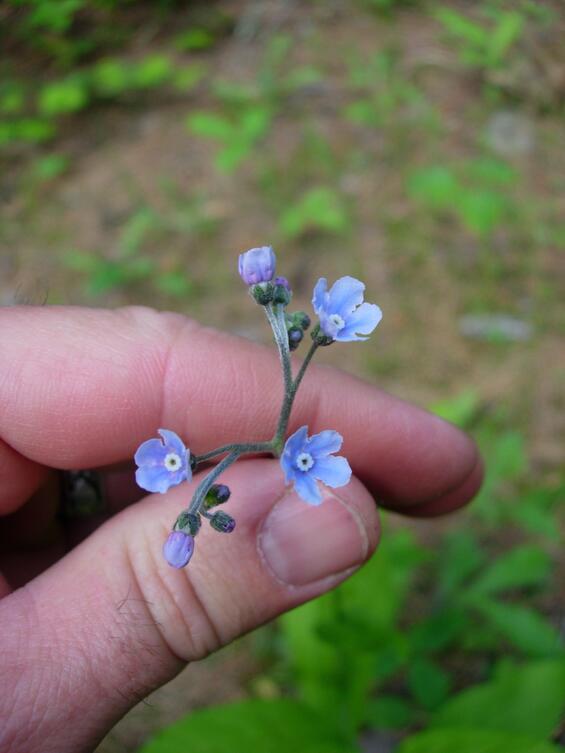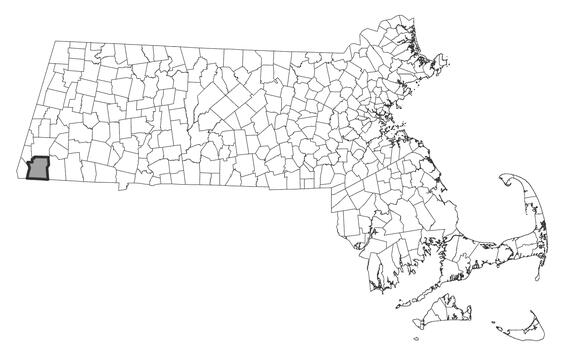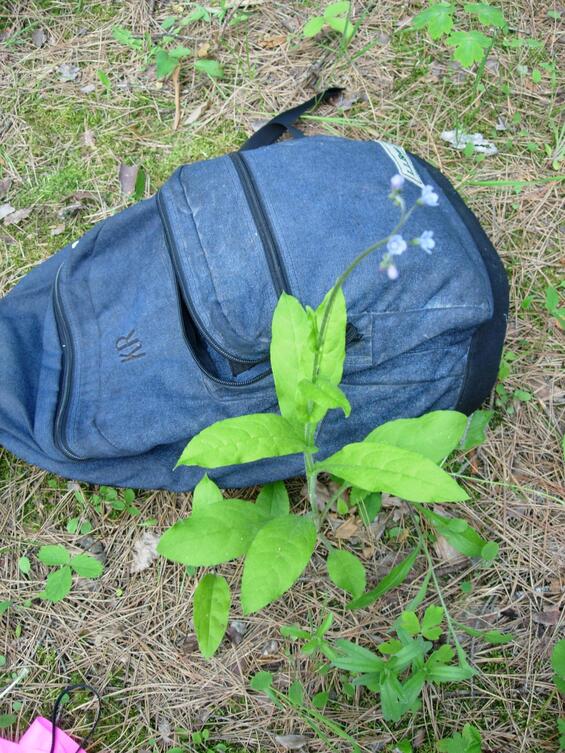- Scientific name: Andersonglossum boreale (Fern.) Jim.Mejías, J.I.Cohen & Naczi
- Species of Greatest Conservation Need (MA State Wildlife Action Plan)
- Endangered (MA Endangered Species Act)
Description

Photo credit: Robert Wernerehl
Northern wild comfrey, a member of the forget-me-not family (Boraginaceae), is a perennial understory herb of rich woods and thickets. This species is long-lived and non-clonal. Immature and non-flowering (i.e., vegetative) plants live as a tap-rooted basal rosette with one to seven roughly hairy leaves. The basal leaves have long petioles, are oval in shape, and are 10-20 cm (4-8 in) long. Reproductive plants produce a tall stem, up to 75 cm (~ 2.5 ft) in height, with up to four flowering branches. The stem bears alternate, pubescent, smooth-margined leaves that are most dense at the base of the plant and decrease in size and abundance upward. The upper leaves are sessile and clasp the stem with a heart-shaped base, but the lower leaves have distinct petioles. The flowering portion of the plant is terminal and leafless, and bears branches of five-petaled, lavender or light blue flowers, 5-8 mm (0.20-0.31 in) wide. The petals are oblong and don’t overlap. The fruits are bristly nutlets, 3.5-5 mm (0.14-0.20 in) in size. The bristles are capable of attaching to clothing and fur, enabling animal seed dispersal.
Northern wild comfrey must be reproductive in order to confirm the identification. Flowers are present in late spring to early summer, and fruits develop in early to mid-summer. The following characteristics help identify northern wild comfrey:
- Hairy, oval basal leaves with long petioles
- Petioles on lower stem leaves, upper stem leaves clasping
- Terminal inflorescence, with four or fewer branches
- Pale blue or lavender flowers, 5-8 mm (0.20-0.31 in) wide
- Oblong petals that don’t overlap
- Nutlet 5 mm (0.20 in) or smaller
The most similar species to northern wild comfrey is wild comfrey (C. virginianum var. virginianum), a species known from Connecticut but not documented from Massachusetts. The two species are similar in habit and inflorescence, but wild comfrey is generally a larger plant, with larger flowers (8-12 mm [0.31-0.47 in]) and nutlets (6-8 mm [0.24-0.31 in]). Further, all of the leaves of wild comfrey are sessile, and the petals are more rounded and overlapping.
Massachusetts does have one common species of cynoglossum, hound’s-tongue (Cynoglossum officinale), which is an exotic species of fields, pastures, and disturbed areas. Unlike the rare species, it produces some inflorescences from the leaf axils and has reddish purple flowers. Two other similar exotic species, Chinese hound’s-tongue (C. amabile) and small bristled hound’s-tongue (C. microglochin), are considered “waifs” in Massachusetts and are unlikely to be found within intact forested habitats. These two species have pale bluish flowers and also produce some axillary flowering branches.
Life cycle and behavior
This is a perennial herbaceous species.
Population status
Northern wild comfrey is listed under the Massachusetts Endangered Species Act as Endangered. All listed species are protected from killing, collecting, possessing, or sale and from activities that would destroy habitat and thus directly or indirectly cause mortality or disrupt critical behaviors. This species is currently known from Berkshire County and is historically known from Franklin, Hampshire, and Worcester Counties. The MassWildlife’s Natural Heritage and Endangered Species Program database has 3 records from 2 counties: Berkshire and Franklin. Only 1 of these records has been observed within the last 25 years.

Distribution and abundance

Photo credit: Robert Wernerehl
Northern wild comfrey is documented from the Maritime Provinces south to New Jersey, Pennsylvania, and Ohio, and west to Yukon Territory, British Columbia, the Dakotas and Wyoming. It is rare in or presumed extirpated from several states and provinces across its range. In New England, northern wild comfrey is considered critically imperiled in Maine, Massachusetts, New Hampshire and Vermont. It is possibly extirpated in Connecticut, and is not known to have occurred in Rhode Island. It is also critically imperiled in New York state, and possibly extirpated in Pennsylvania and New Jersey (NatureServe 2025).
Habitat
In Massachusetts, northern wild comfrey inhabits rich mesic forests in areas with some light exposure, such canopy gaps, edges, and ledges with sparse tree cover. The soils are rich, typically calcareous, and often rocky. Associated species include thread-leaf sedge (Carex eburnea), early meadow-rue (Thalictrum dioicum), wild columbine (Aquilegia canadensis), blue-stem goldenrod (Solidago caesia), fly-honeysuckle (Lonicera canadensis), and fringed polygala (Polygala paucifolia).
Healthy habitats are vital for supporting native wildlife and plants. Explore habitats and learn about conservation and restoration in Massachusetts.
Threats
As northern wild comfrey requires light exposure, canopy closure resulting from a lack of disturbance (e.g., canopy gap formation, from fire or storm damage) is a primary threat. In addition, herbivory by deer is a major threat in areas with dense deer populations. Lastly, invasions of exotic plants, such as garlic mustard (Alliaria petiolata), which produces chemicals that inhibit the growth of other species, and Japanese barberry (Berberis thunbergii), a common invader of rich forests may be a threat at some locations. This being a species of more northerly distribution, climate warming is a potential threat. The past 130 years have seen a warming of 1.4 degrees C, (2.5 degrees F) in the Northeast United States (Staudinger et al. 2024). Northern species can be expected to move much further north in an attempt to occupy a habitat within their evolved climate envelope. Temperature and seasonality changes also disrupt synchronization of pollinators to plant flowering.
Conservation
As this plant is under-surveyed, a serious effort should be made to conduct de novo surveys in areas where this is likely to occur or resurveys where records are over 25 years old.
In areas where the forest is dense, northern wild comfrey may benefit from canopy thinning or pruning, and removal of competing understory plants. It may be important to control exotic invasive, and certain aggressive native plants at the same time that light is increased, because these competitors will also benefit from the management. All active management of state-listed plant populations (including invasive species removal) is subject to review under the Massachusetts Endangered Species Act and should be planned in close consultation with the MassWildlife’s Natural Heritage and Endangered Species Program.
The exact ecological needs of this species are not well understood. As this plant is under-surveyed, standard information is needed such as lists of associated species, comments on habitat quality and threats, and assessments of soil conditions and phenology. Research is needed to determine whether this plant can be grown in a greenhouse or garden setting for purposes of reintroductions. If habitat degradation accelerates losses of current populations, this strategy could prove useful to long-term conservation of this species.
References
Abrams, E. and W.E. Brumback. 2001. Cynoglossum virginianum var. boreale (northern wild comfrey). Conservation and Research Plan. New England Plant Conservation Program, Framingham, Massachusetts.
NatureServe. 2025. NatureServe Network Biodiversity Location Data accessed through NatureServe Explorer [web application]. NatureServe, Arlington, Virginia. Available https://explorer.natureserve.org/. Accessed: 6/5/2025.
Staudinger, M.D., A.V. Karmalkar, K. Terwilliger, K. Burgio, A. Lubeck, H. Higgins, T. Rice, T.L. Morelli, A. D'Amato. 2024. A regional synthesis of climate data to inform the 2025 State Wildlife Action Plans in the Northeast U.S. DOI Northeast Climate Adaptation Science Center Cooperator Report. 406 p. https://doi.org/10.21429/t352-9q86
U.S. Forest Service. 2005. Conservation Assessment for northern wild comfrey (Cynoglossum virginianum var. boreale (Fern.) Cooperrider. Eastern Region of the Forest Service - Threatened and Endangered Species Program, Milwaukee, WI. Online http://www.fs.fed.us/r9/wildlife/tes/caoverview/docs/Plants/Cynoglossum_virginianum_var._boreale.pdf
Contact
| Date published: | May 15, 2025 |
|---|